The Golden Temple, also known as Harmandir Sahib, is one of the most revered spiritual sites in India and a major pilgrimage destination for Sikhs and tourists alike. Located in Amritsar, Punjab, the temple is a magnificent symbol of peace, spirituality, and cultural heritage, drawing millions of visitors every year. Its striking architecture, with a gold-plated sanctum surrounded by the sacred Amrit Sarovar (holy tank), creates a serene and breathtaking environment that captivates all who visit.
The Golden Temple is not just a religious center but also a hub of cultural and social significance. The complex is open to people of all faiths, emphasizing Sikhism’s core values of equality, humility, and community service. Pilgrims and tourists alike are welcomed to participate in rituals, meditate, or simply enjoy the peaceful ambiance.
The temple’s Langar (community kitchen) is one of the largest in the world, serving free meals to tens of thousands of visitors daily, regardless of religion, caste, or social status. This practice embodies the Sikh principles of selfless service (Seva) and equality.
Surrounded by marble walkways, intricately designed gateways, and lush gardens, the Golden Temple offers a harmonious blend of spirituality and architectural beauty. The reflection of the golden structure in the still waters of the Amrit Sarovar enhances its grandeur, especially during sunrise and sunset. The temple complex also houses several important Sikh institutions, museums, and libraries, providing insight into Sikh history, traditions, and values.
Visiting the Golden Temple is a journey of the heart and soul, offering tranquility, spiritual upliftment, and a chance to witness the devotion and hospitality of the Sikh community. Whether exploring the ornate interiors, participating in the evening Palki Sahib ceremony, or enjoying the soothing atmosphere of the holy tank, the experience is both humbling and unforgettable.
History
The Golden Temple, or Harmandir Sahib, has a rich history dating back to the 16th century. The foundation stone was laid by Guru Arjan Dev Ji, the fifth Sikh Guru, in 1581. The temple was designed to be a place of worship for people of all faiths, reflecting Sikhism’s universal values of inclusivity and equality.
Initially constructed with marble and limestone, the temple was later adorned with gold plating during the 19th century under Maharaja Ranjit Singh, who contributed significantly to its expansion and beautification. The central sanctum is surrounded by the Amrit Sarovar, a holy tank believed to possess healing properties, where pilgrims take a ceremonial dip as an act of purification.
Throughout history, the Golden Temple faced invasions and destruction but was meticulously rebuilt each time by devoted Sikh communities. It has stood as a symbol of resilience, faith, and devotion, surviving through centuries of political turmoil and cultural change.
The temple’s architecture is a blend of Mughal and Rajput styles, with marble inlay, intricate frescoes, and gold-plated domes. Its four entrances symbolize openness and acceptance, welcoming people from all directions and faiths.
The Golden Temple also holds immense historical significance due to events such as the compilation of the Guru Granth Sahib, the holy scripture of Sikhism, inside the temple by Guru Arjan Dev Ji. Over the centuries, it has become the spiritual and cultural heart of Sikhism, hosting important festivals like Vaisakhi, Diwali, and Gurpurab, which attract thousands of devotees worldwide.
Today, the temple complex includes the Akal Takht, the supreme seat of Sikh authority, and several educational and charitable institutions, reflecting the Sikh ethos of service, learning, and community support.
Nearby Places to Visit
1. Jallianwala Bagh
Located near the Golden Temple, Jallianwala Bagh is a historical site commemorating the 1919 massacre. Visitors can explore memorials, preserved bullet marks, and gardens while reflecting on India’s struggle for independence.
2. Partition Museum
Dedicated to the history of India’s partition in 1947, the museum offers exhibits, photographs, and personal stories, providing deep insights into the human impact of this historical event.
3. Durgiana Temple
A prominent Hindu temple in Amritsar, Durgiana Temple features architecture similar to the Golden Temple, with sacred water bodies and intricate carvings, making it a peaceful spiritual site.
4. Wagah Border
About 30 km from Amritsar, Wagah Border is famous for the daily flag-lowering ceremony between India and Pakistan, a patriotic spectacle attracting locals and tourists alike.
5. Gobindgarh Fort
A historic fort in Amritsar, Gobindgarh Fort offers museums, cultural performances, and light shows, providing insights into Punjab’s history and martial traditions.
Best Time to Visit
The best time to visit the Golden Temple is October to March, when the weather is cool and pleasant. Festivals like Diwali and Gurpurab are particularly vibrant, offering visitors an opportunity to witness spectacular decorations, ceremonies, and cultural celebrations.
How to Reach
Amritsar is well connected by road, rail, and air. The nearest airport is Sri Guru Ram Dass Jee International Airport, about 12 km from the temple. Amritsar Junction railway station and regular buses from major cities provide easy access. Local taxis and auto-rickshaws make commuting within the city convenient.





0 comments:
Post a Comment